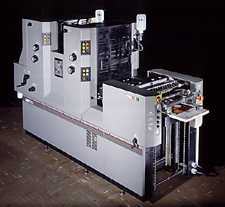

NO MATTER how neat or clever a product may be, if it is housed in a grey box of some sort - as is often the case - then it will tend to look rather ordinary when photographed. And if the client wants something particularly eye-catching, you could find yourself fighting a losing battle unless you have a trick or two up your sleeve. One such trick is to use selective focusing, picking out a manufacturer's logo or other important area that contains an element of colour. Another trick is to use coloured lighting.
The shot shown here was taken for the cover of a trade magazine, with a brief to create something that would stand out. As a visual pun on the printing industry, which the magazine served, it was decided to light the press with yellow, magenta and cyan light.

Since the picture was shot on location in a print-room environment, the first objective was to isolate the machine from its surroundings. A large black velvet sheet - Lastolite Imperial Curtain - was used for this purpose. Next, the important aspects of the press were identified by an operator so that the picture could be taken from a sensible angle. At this stage, particular attention was paid to dark areas that might disappear into the background if not fully lit. The lights (in this case, Photon Beard tungsten heads) were then brought in one at a time. The large side panel of the press was lit with a broad flood; a 2000W blonde lit the bottom of the front of the press (from the right of the picture) with a 800W redhead placed above it; all these were standard Photon Beard lights. Finally, a couple of small spotlights were used to illuminate the gaps between sections of the machine where adjacent uprights had cast shadows.
Throughout the initial lighting set-up, everything was kept natural colour. This was done to ensure that efforts were concentrated on one thing at a time. Only after the lighting was balanced were coloured filters added. Minor adjustments in brightness were then necessary to re-balance the lights, using PB's light control wire scrims and double-folded sheets of filter gel. Only after all this was done was an exposure reading was taken. The shot was then tested with Polaroids before being shot on 5 x 4" Kodak 64T.
Because the image was intended for use as a cover photograph, plenty of space was left above and below the main image. Since those areas are not part of the picture itself, they have been cropped off here (original 5 x 4 vertical).